A kayak is often seen as an investment. Indeed, it won’t break the bank, but you’ll still spend a good amount of money on it, not to mention any extras. With these thoughts in mind, you want to make sure you’ll get years of fun adventures out of your kayak.
Light maintenance every now and then is quite important. It depends on the material your kayak is made of. Then, think about the right type of storage during bad seasons when you can’t take it out. And as if all these were not enough, covers for kayaks are just as handy to keep them in even better conditions.
Even if you actually keep the kayak inside a shed, a garage, or perhaps your home, a cover will still offer better protection. Not only can it protect the kayak from dust and dirt, but it will also preserve the finish and ensure it won’t scratch when touching other things in the area.
A kayak cover is a must to ensure your unit stays in the best possible condition. But with so many options out there, choosing the right one can be tricky. Here’s everything you need to know before spending your money.
Benefits of covers for kayaks
Like anything else that could do with a cover, kayaks will be kept in a better condition in the long run if properly protected. It’s good for your fun, as well as your pocket. Maintaining your kayak in perfect condition means you won’t need to spend money on repairs or replacements every couple of years.
But why else would you use covers for kayaks?
UV protection
In a world where everyone pays attention to light scratches, the finish, and the actual integrity of the unit, no one really pays attention to the sun. Unless you store your kayak in a shed or a garage with no windows, sun damage is naturally part of the game.
When exposed to direct sunlight for long periods of time, kayaks deteriorate in no time. The problem is you won’t notice this gradual process until it’s too late. With these thoughts in mind, storing the kayak out of sunlight is a must and a cover can help you achieve it.
The Lucky Monet Kayak Cover checks all these requirements and actually has a reputation for its UV resistance.
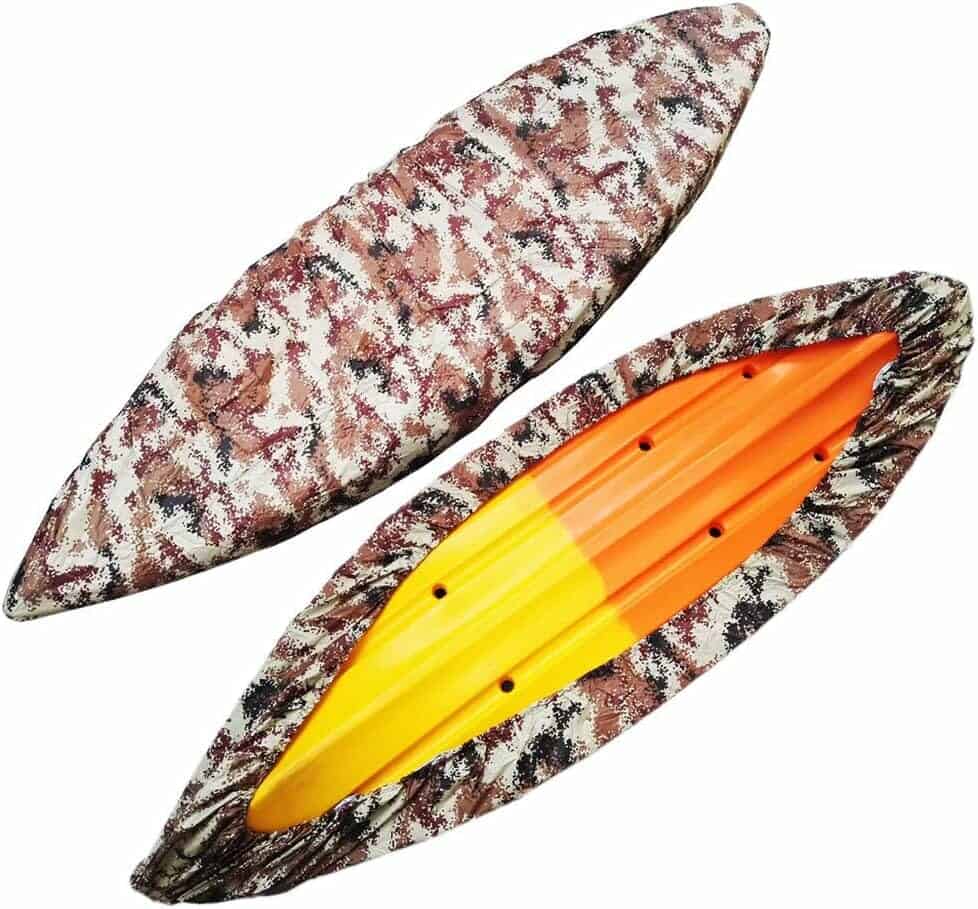
Best UV Protection
- Marine-grade 210D oxford fabric with PU and UV coating ensures superior protection.
- UV 50+ protection shields your kayak from sun damage.
- Waterproof and dust-resistant, offering year-round, all-weather protection for your kayak.
No critters
Storing your kayak over the cold or rainy season means you’re less likely to use it for months. This means it will become the ideal home for all kinds of critters. Spiders are perfectly normal and you’re probably used to a few cobs here and there.
But then, depending on the type of kayak you have, some critters could cause serious problems. For instance, if you have a closed cockpit type of kayak, birds and rodents are likely to use it for a home. Birds prefer privacy, while rodents will have a place to hide.
Just because you have a sit on top kayak, it doesn’t mean you should overlook covers for kayaks either. In fact, once the spring kicks in, you’ll notice quite a lot of grime leftovers once these critters decide to move out.
Keeping the kayak in a shed or a garage will, indeed, limit some of these infestations. It’s not a guarantee though, as many of them are persistent and chances are you already have some in your garage already.
Safe transportation
Most people don’t really bother about a cover when transporting their kayaks, whether they use trailers or they just fit them on roof racks. A light cover won’t protect it against an accident, but it will definitely help you keep your gear in good condition.
It also means that your maintenance and professional storage throughout the wintertime wasn’t in vain. All this work won’t be ruined by dirt and debris from the road messing the kayak. However, keep in mind that some covers are made for storage only.
Dust protection
Dust seems insignificant. After all, you can just wipe it all away. But then, it’s also tiny, meaning it can get into every single nook of your kayak, whether you move it around or you store it for the winter. It can cause serious problems if it gets into bolts or glued foam, as parts will come unstuck.
Obviously, this is less likely to happen overnight. It takes months or maybe even years of lack of care. But then, even if you’re not there yet, you want your kayak to look nice and shiny, rather than dirty and disgusting.
Water protection
It may sound a bit sketchy, after all, water isn’t supposed to damage kayaks. It’s their environment. Now, there’s a difference between spending a few hours paddling and leaving your kayak in standing water for a few months during the wintertime.
Make sure your kayak is well dried before storage, as standing water can cause mold. A cover will also help against water if the kayak is stored outside, as well as humidity if it’s stored in a shed or a garage, which can cause similar issues.
Types of covers for kayaks
Generally speaking, there are two types of covers, each of them with its unique features.
Bag covers
Bag covers for kayaks are the most popular styles out there because they offer excellent protection. They’ll keep your kayak in good condition throughout storage and transportation. Their name is self-explanatory.
The kayak slides inside the bag, which zips all around it. Despite offering such good coverage, not all bag style covers are suitable for outdoor storage. If you store your kayak outdoors, make sure the cover is waterproof. It should also have well stitched zips to ensure water doesn’t get in.
The Hobie Universal Fit Cover offers both a full cover and the world renowned polyester durability.
Such covers are close to being watertight, so it’s imperative to ensure your kayak is perfectly dry before storage. They’re a bit difficult to put on, but easier to remove. For this reason, most people don’t use them after each kayaking session, but only for long term storage.

Best Bag Cover
- Adjustable straps and pull strings ensure a snug and secure fit for your kayak.
- Cross straps enhance stability and safety during transportation.
- Featuring UV and water-resistant 100% polyester construction
Shower cap covers
Shower cap covers work like actual shower caps. Take a look at the Hobie Pro Angler Cover to get an idea. They slide over the top of the kayak and they get tighter towards the middle part. They tighten by the edges, ensuring a good fit. They often come with clips or straps to ensure they can’t be blown away.
Compared to bag style covers, they’re much easier to put on and remove. They’re not as secure though, yet they still offer a high degree of protection. The base of your kayak will be exposed though, so it may still be affected by certain weather conditions, such as extreme temperatures.
If you’re planning to store your kayak for a long period of time, this type of cover is great if you do it indoors. At the same time, the kayak should be kept off the ground.
If you have a sit on top kayak, get the plugs in and then cover the unit. This way, bugs, and water won’t be able to enter the kayak through those holes.
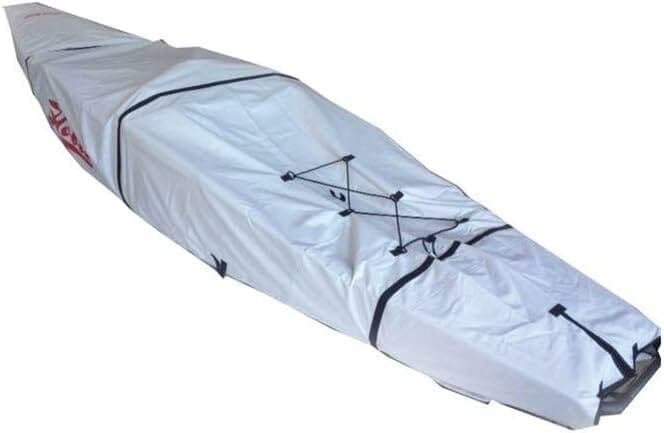
Best Shower Cap Cover
- Easily adjustable straps and pull strings ensure a secure, custom fit for your Pro Angler 14 kayak cover.
- Additional cross straps offer enhanced security and stability during transportation.
Most common materials for covers for kayaks
It’s important to understand that the material is probably the most significant element when considering covers for kayaks. High quality materials offer lots of protection and can keep your kayak in good conditions. Poor quality materials will only protect against dust and debris.
As a general rule of thumb, covers must be based on tough materials. The heavier it is, the more difficult it will be to fit it on the kayak. But then, it’s totally worth it due to the extra level of protection. Other than that, each material has its own qualities.
Polyester
Polyester is the ultimate choice for covers for kayaks. For this reason, it’s also very common among big brands. It has a solid and high denier fabric, meaning it will last for ages without compromising on its protective capabilities.
Not only is it durable, but it can also take all kinds of weather conditions, as well as general wear and tear. As if all these were not enough, polyester can also resist water. If treated correctly, it could be waterproof as well. Just check the specifications before investing in a cover.
The Classic Accessories StormPro Heavy-Duty Kayak Cover is practically indestructible and features 600 denier polyester.
StormPro Heavy-Duty Kayak Cover
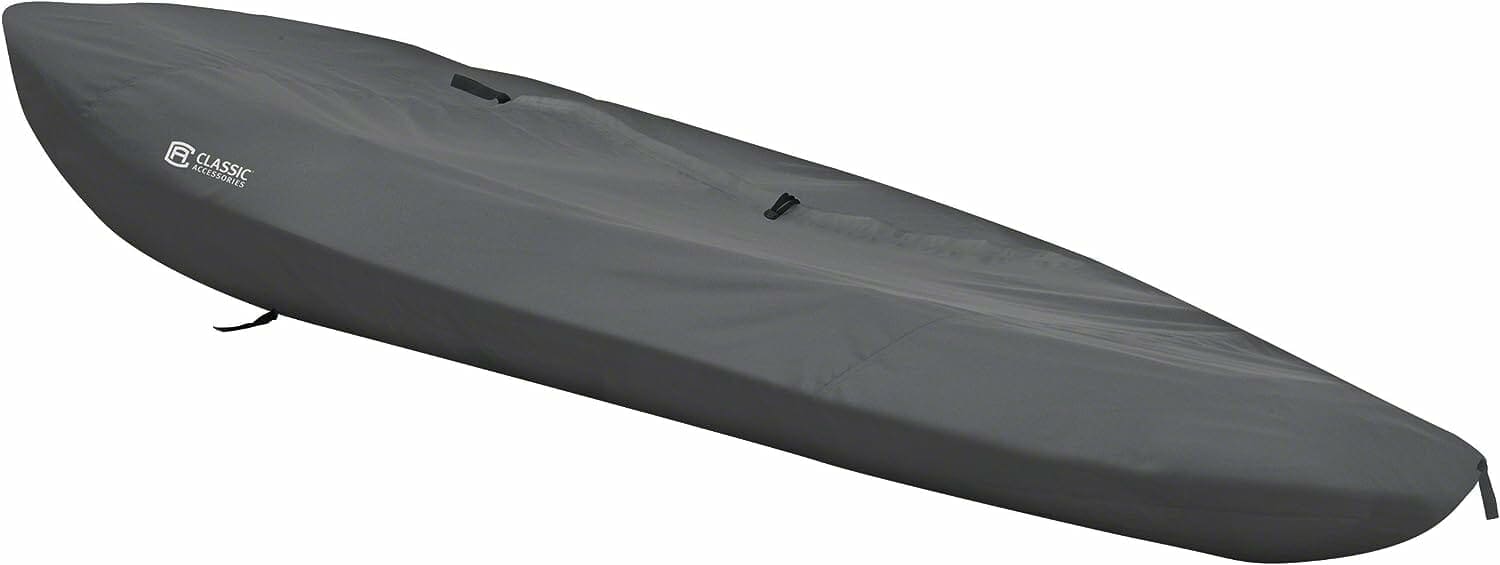
Best Polyester Cover
- Suitable for most kayaks or canoes up to 12 feet in length, with a full-cut design to accommodate extra gear like paddles and life vests.
- Crafted from heavy-duty 600D polyester that’s PVC-free, this cover won’t shrink or stretch, designed for exceptional durability.
- Advanced fabric coating technology ensures maximum water repellency and protection, with structured vents to prevent wind lofting, all-weather resistance, and durability.
Neoprene
Neoprene is another common material in covers for kayaks. It’s most commonly used for cockpit covers, which are relatively easy to fit. They have good waterproof capabilities and are highly recommended for protection during long distance transportation.
Neoprene is not as tough and solid as polyester. However, it offers better waterproof protection, yet it depends on the brand and manufacturing process. It’s not expensive and will usually offer good value for money.
Oxford cloth
Oxford cloth has nothing to do with waterproofing. If you store your kayak outdoors and you have lots of rain or snow, this isn’t the best option. It becomes useless in front of water. For this reason, Oxford cloth is considered a cheaper and less effective material for covers for kayaks.
The good news is it’s durable and does offer excellent UV protection. Some brands also treat their Oxford cloth covers for waterproof features, but these capabilities are limited. If you do go for this option, make sure the cover is 200 denier or higher.
The Dulcii Universal Cover offers a pretty good choice in this product range.
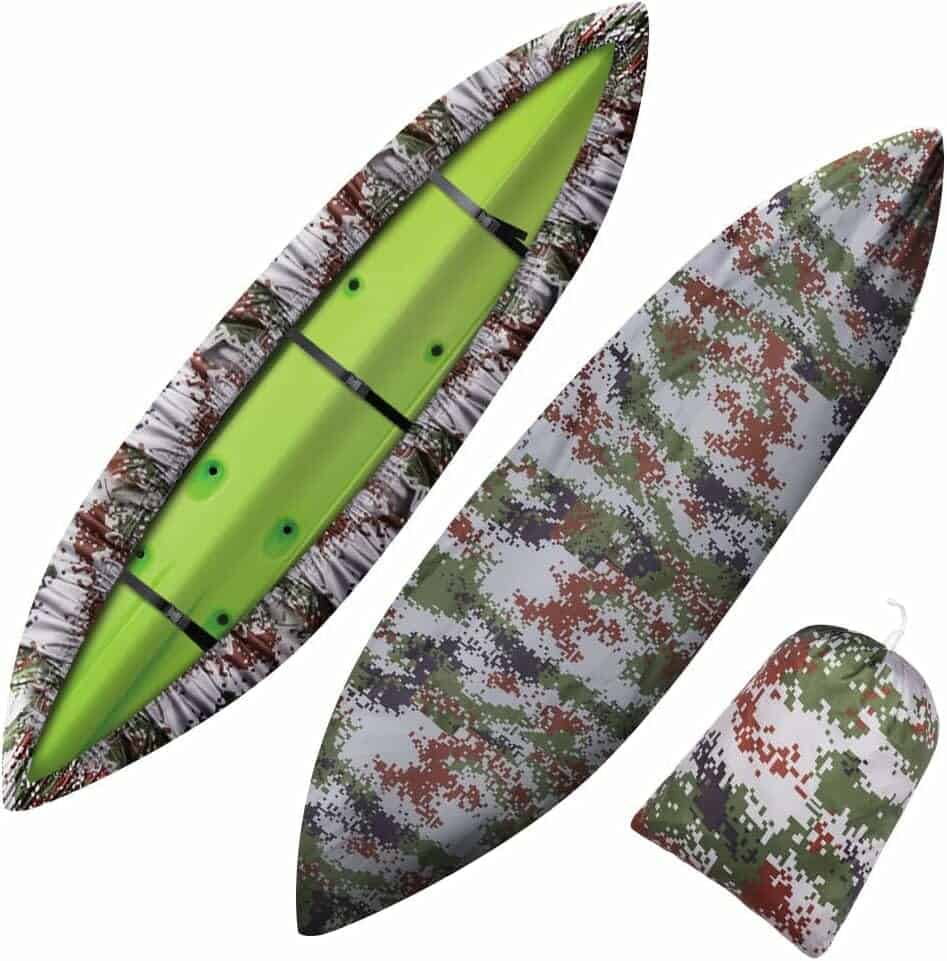
Best Oxford Cloth Cover
- This kayak storage cover offers UV resistance, sun protection, and is waterproof.
- Designed for long-term protection against sun, rain, snow, and other damaging elements.
- Easily adjustable with 2 straps for a secure fit, this cover requires no additional tools.
Cockpit covers, a decent alternative
Cockpit covers can be considered covers for kayaks too, despite offering limited protection. They’re not like classic full kayak covers. Instead, their name makes it pretty obvious, they only cover the cockpit of your kayak.
This means large parts of the kayak are still exposed. UV damage is still a risk, not to mention water and weather exposure that may have similar consequences.
So, why would anyone choose cockpit covers over covers for kayaks then? Their role is to stop water, dust, debris, dirt, and critters from getting into the cockpit. Anyone can fit such covers and they’re also suitable for transportation.
What to look for in covers for kayaks
There are quite a few things to keep in mind when about to purchase a cover for your kayak.
Size
The size is by far the most important aspect. After all, you need your cover to match the kayak or it becomes completely useless. If you can’t fit the whole kayak in, only parts of it will benefit from a low amount of protection.
Too large is not always a good idea. If a small cover won’t offer full protection, a large one may fall off. It sounds difficult to pick based on the size, but double check the brand’s size chart upfront. For instance, the Gymtop Waterproof Kayak Cover comes in a few different sizes for maximum convenience.
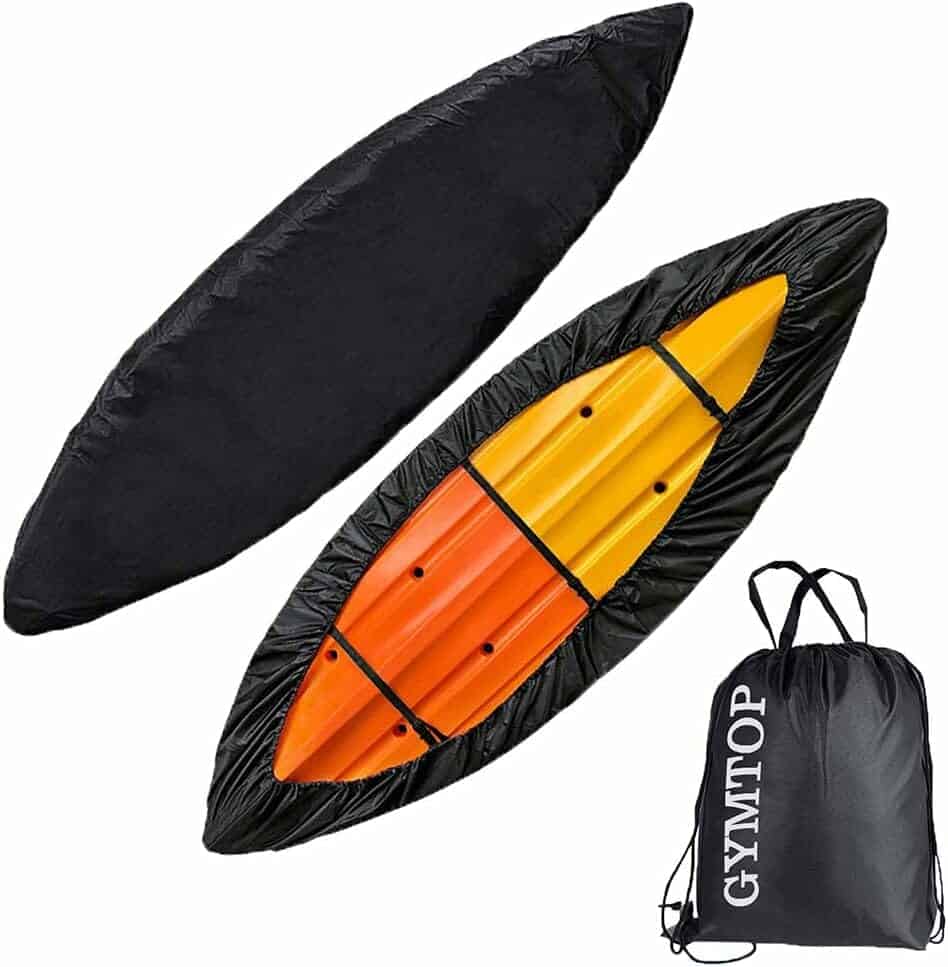
Top Pick for Large Kayak Covers
- Ideal for large kayaks, available in multiple sizes.
- Added adjustable reinforcement band for secure fitting.
- Includes a convenient drawstring bag for easy transport and storage.
Storage
Now, why are you browsing covers for kayaks? You obviously want some protection for your kayak, but what for? Storage is the most common answer. Is it indoors or outdoors? Requirements will clearly vary based on the weather.
If you choose outdoor solutions, the Best Marine Kayak Cover offers protection against sun, water, snow, and wind. If you need the cover for transportation, unless you travel through a rainy day, waterproof capabilities are not that important.
Thickness
The thickness of the material is just as important. It will help you determine how durable it is. Plus, a thick cover offers good protection against tears too. Normally, you should opt for a unit with 200 deniers or more.
Take the iCover Kayak Cover and you’ll understand what thickness means. With 600 denier and reinforced stitching, this is the type of cover that will offer outstanding protection for years, without showing any signs of wear and tear.
Obviously, the material is just as important, not to mention the type of cover. Each company or brand will offer some warranties too, which should also be taken into consideration.

Top Pick for Thick Kayak Covers
- Suitable for most kayak sizes.
- Crafted from heavy-duty fabric with reinforced stitching.
- Includes a convenient storage bag.
FAQs
Still undecided about the best covers for kayaks?
What size kayak cover should I buy?
If the cover doesn’t fit perfectly, its protective capabilities will be dramatically reduced. If it’s too large, it may slip off, while water and critters may still find a way in there. For maximum protection, it should be a bit tight. Too tight is not good either, as you’ll struggle to put it on.
To make sure you get the right cover, measure your kayak and double check size charts before ordering.
Are kayak covers waterproof?
Not all covers for kayaks are waterproof. Pay attention to the specs, materials, and its thickness. Some units are waterproof, while others provide water resistance. They’ll be alright against a light rain, but they won’t manage a rainy season.
Do kayaks need to be covered?
Store your kayak without a cover, whether in a shed or direct sunlight, and its graphics will fade away. More importantly, it may warp or even end up with a different shape if not stored accordingly, hence the necessity to pay attention to this aspect.
Is it alright to leave my kayak outside in winter?
Normally, a kayak should survive outside, despite all the weather elements. But then, it won’t be perfectly safe. Apart from potentially losing its shape, it could also face UV and water damage, not to mention critters trying to build homes around it.
How do I store my kayak outside for the winter?
Assuming you can’t store your kayak indoors, browse the best covers for kayaks and find a thick and impermeable unit with waterproof capabilities. You’ll need this type of material.
Then, even if you can’t store the kayak inside, at least keep it elevated. Otherwise, it will be in standing water for long periods of time.
Wrapping up…
Covers for kayaks do play a significant role in the maintenance process of your kayak. It’s an investment that will pay for itself in the long run. It will prevent all kinds of damage, as well as the necessity of further repairs later on.
A cover is not only great for storage only, but also for transportation. You don’t want your well looked after kayak to end up covered in dust and grime over a long trip to the seaside, not to mention all kinds of insects getting inside it.
Now, with so many options out there, picking the right one could be tricky. There are more types of covers for kayaks, as well as different manufacturing standards, materials, thickness standards, and extra features.
What works for some people won’t necessarily work for everyone else, so you’ll need to consider where you normally store your kayak, what kind of climate you live in, and how often you use it. Make this decision with your unique needs in mind.
Bottom line, remember, your cover won’t do everything for you. It does offer a solid layer of protection, but it also depends on where you store the kayak and in what conditions.


3 thoughts on “Covers for Kayaks – How to Choose the Best Cover”